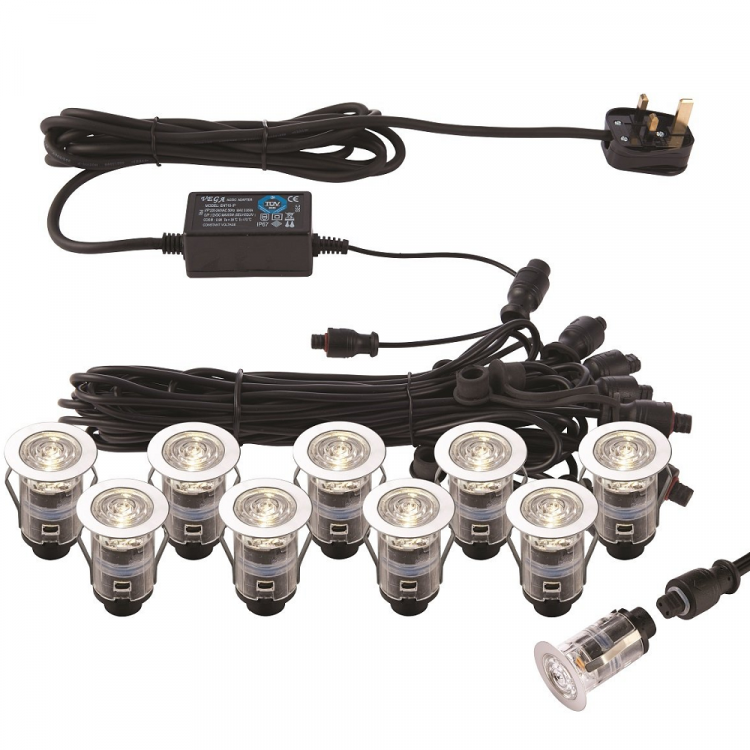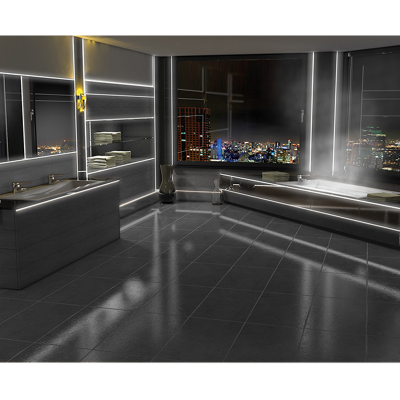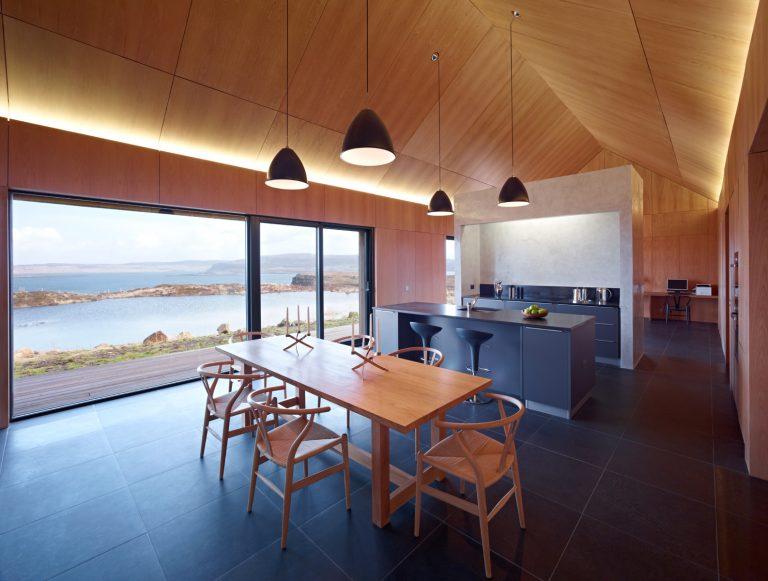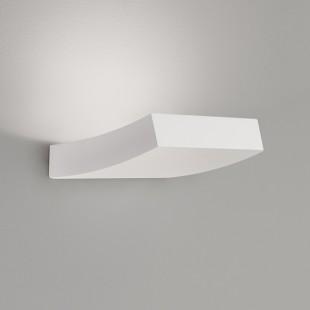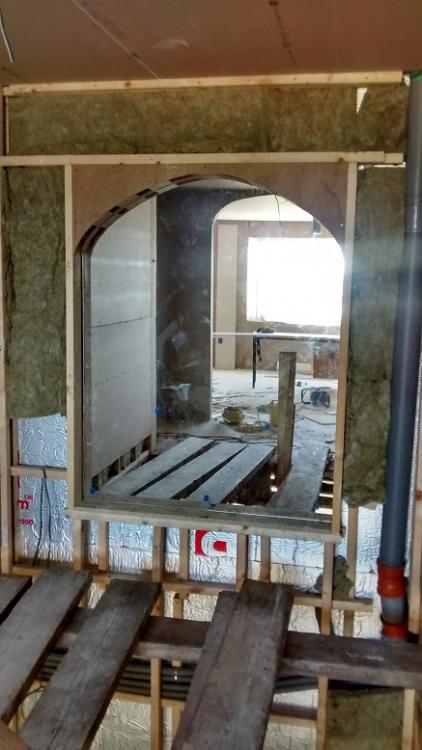Search the Community
Showing results for tags 'led'.
-
Our bath will be freestanding, maybe about 50 - 100 mm away from the wall at most. We wanted some LED lights on the wall behind and below the bath for the occasional chilled out soak . Our M&E guy was going to send us a link to some lights that he thought would do the job well but we didn't get that. I'm pretty sure that something like this is what he had in mind. They are decking lights and IP67 rated. It seems like a great idea to me but how would we do it? I know almost zip about electrickery. At the moment we have a grey cable coming through a hole in the plasterboard that is for LED lights. Do we just: 1. Cut the string of lights off from the transformer. 2. Join that string of lights to the in situ cable. 3. Find the other end of the in situ cable and attach the transformer to that. 4. Plug in. Switch on. Chill out? Or is it way more complicated than that? Help appreciated ?
-
Couldn't find anything on google about this so thought I'd try here.... I used to have two cheap solar led lights on my shed outside and whenever a bus was parked on the road opposite they would go off despite no line of sight to the PIR. I've since retired them and have a reputable version out from covering a small nook there. A wierd thing happens when 1 particular car passes by, the light turns on, but it doesn't do this for any other car and there is a good 9-10 meter distance. I have to stand within 3-4 meters to set it off myself. So, question begs what sort of EMI or interference could cause this? Just curious! Thanks.
-
Building on the content of this topic on connecting LED strip lighting drivers to the mains, a little bird whispered in my ear, loud enough for me to worry ( - overthink - Ok @Russell griffiths ? ) about where I can / should / may /may not / would / could / oughtn't to / may / am permitted to place the drivers. You know, those things that are called drivers, but are transformers really. Thinking about fire regulation, are there any rules where they may not be placed ? Of course, it makes sense to place them in an accessible place for maintenance reasons - but what about ceiling spaces where sound insulation might increase their working temperature. Can I bury one in some of the over-abundance of insulation that exists in my front wall?
- 2 replies
-
- led
- transformer
-
(and 2 more)
Tagged with:
-
Working around the joiners as they completed the internal fit out, the electrician returned to complete second / final fix. I won’t bore you with endless photographs of sockets and light switches, but will describe the most notable electrical installations: LED lighting – after obtaining various samples and some electrical testing, I purchased a quantity of slimline 6W recessed fittings from https://hartingtonheath.com/product-category/led-recessed-lights/non-dimmable/ I bought mine via their ebay outlet which gave me an additional 10% off. The electrician was a little dubious, primarily on the issue of the cut out size required being greater than a standard downlight. We went ahead and fitted them in the kitchen, utility, staircase and upper floor. Each light comes with its own driver so to wire up to the mains, a connector block enclosed in a 'choc' box was used. This did increase the amount of time required to install each fitting, but the actual cost of the fitting was significantly lower than the more traditional alternatives we had previously looked at. The light they give off is fantastic and they really do seem to disappear into the ceiling, far more so than many standard downlight designs I’ve seen. Apologies for the quality of the pictures! The slimline design was especially helpful when fitting in the coomb ceiling as there was no requirement to hack into the insulation as the fitting sat comfortably in the service void. Chatting to the electrician, he commented that they had now adopted this type of downlight because of the flexibility it offers. Our next luxury was a 5A lighting circuit - fitted in the main room so we can switch off all the occasional lamps used from a master switch. Simple, effective home automation! To future proof the house we installed Cat 5E data points to every room, with the hub located in the meter cupboard next to the BT master socket. I've located my BT router there and currently hard wire direct from an ethernet port on the back of the router to the port on the hub for the data point in use. There are still 2 ethernet ports left on the router, however, if I want to make any more than three of the data point live, I'll need some additional equipment (not really sure what would be required so following various current topics with interest). Whether we end up using all or indeed the majority of the data points, I have no idea, but it certainly made sense to put all the cables in. The last electrical item of note was a CO2 detector – a wonderful (Scottish) building regulation designed, I think, as a way for large developers to avoid having to fit a mechanical ventilation system, because householders have a means of monitoring air quality and therefore a way to manage it – by opening windows etc. At £200 they are not cheap (but from a developers point of view, a lot cheaper than an MVHR system). Here is the link to the relevant requirement - look up part 3.14.2 http://www.gov.scot/Topics/Built-Environment/Building/Building-standards/publications/pubtech/th2015domcomp No doubt this regulation will creep in elsewhere in the UK. I did have quite lengthy discussions about whether we could use a CO2 sensor in the MVHR to actively manage our ventilation. The idea of doing so was certainly very positively received and thought to be a far better / more sensible approach, but unfortunately, there was no getting round the installation of a stand alone detector as the Vent Axia sensor that you could integrate with my MVHR didn’t have the specifications required in the regulations. At £350, it was also significantly more expensive. If you read through the specification, you’ll notice that one of the requirements is that the sensor alarm must be capable of being switched off, which does make you wonder, why bother? Next entry: MVHR final connections and commissioning.
-
Hi I want to install some downlighting in a bathroom in our current house but the information will be handy to have if we ever get planning for the new house. What I am confused about is different lights and loft insulation. Is there a clear rule for light type if I want to have loft insulation over and around the light. I can buy fire rated downlights and I can buy led lights that give off very little heat compared to the older style low voltage hot as hell ( halogen ) ones, but can the fire rated ones be completely covered or do they still need a hood over them? the fire rated are more expensive so is it easier to get a gu10 with led bulb and then install the hood thing over the top. I want to keep the continuation of the insulation as it's a cold draughty house but very conscious of over heating the fitting and fire risk. Cheers russ, confused in Cirencester.
- 14 replies
-
Following on from @readiescards post here, and @PeterW's recommendation in the same thread, we're looking for aluminium profile to carry the LED strip. This supplier (recommended by Peter) sells alu profile. Is it me, or are there really some profiles 10 times the price of others? And are the more expensive profiles 10 times better? BTW, I found this nice little video comparing diffusers for LED strips Anyone got any SNOG MARRY or AVOIDS?
- 10 replies
-
- 1
-

-
- led profile
- aluminium profile
-
(and 1 more)
Tagged with:
-

LED tile trims? Not seen these before.
TheMitchells posted a topic in Electrics - Kitchen & Bathroom
I was looking online at tile trims for the ensuite that we are renovating. I am thinking that a square edge tile trim would be nice, to make a feature of them. however, I just saw these - LED square edge tile trims! Has anyone used them and are they any good? I am wondering how they are powered? Would they need a transformer somewhere?? Any hints on how I could use them to give a little wow factor in my fairly boring ensuite..... https://www.premiumtiletrim.co.uk/product/squarelight-led-square-edge-tile-trim-by-dural -
Hi all, I've wired upstairs bathrooms (3) with Enlite E5 led lamps - all good except possibly the main bathroom which is on the bright side (dimmer switch will sort that out). I have 3 rooms downstairs to do now - kitchen, office & utility. I am keen to inject a bit more science into the calcs here. So I know the lumens & angle of the Enlite E5's and room / desk / worktop heights but what I can't seem to get sorted is how big the splay is on the floor / desk / worktop. I know its a cone of light of various depths (floor / desk / worktop) - does anyone know what the formula for this is? I've found one or two sites that work out the splay but they use their led's and I'd like to get it onto a spreadsheet so I can look at various manufacturers alternative bulbs. Thanks for any light you can shed on the required calculations. CC
-
Starting to work towards our first fix and coming up with lighting solutions. We're big fans of the perimeter wall lighting in the picture below (Dualchas Boreraig) and wondered if anyone has done similar and if so how? Strip LED behind a false facade?
- 1 reply
-
- background lighting
- uplighters
-
(and 1 more)
Tagged with:
-
Of all the different things to think about, decide upon and track down, lighting seems to me to the most annoyingly frustrating. Full of 'professionals ' who when asked simple questions simply can't answer. Or attempt to skirt round the issue and suggest things they have for sale instead. So called Lighting Designers if I meet one at a party, I'm gonna ... ? For example: recessed tracking for LEDs. Not tracking for other types of lights. Or tracking you can see that sits proud of the ceiling or wall. Proper, purpose built tracking designed to take an LED strip that disappears into the wall - or ceiling. I can't find any. Have I just got Fridayitus?
-
Hi all, while I wait for a few items to arrive I thought I'd get some 2nd fix electrics done - the one area I'm not sure on are the bathroom led's. I've bought cheap ones in the past and while I've not had any real probs with then, I'd be happy to go a bit more upmarket for the bathroom - so does anyone have some good recommendations for led's suitable for fitting into bathrooms. Thanks in advance.
-
Just found the plaster wall lights I have been looking for at a great price. £30 instead of £141.00. I visited a passive house local to us that had them & they looked great, but were too expensive. Its feels good to get a bargain. NAXOS LED WALL WASHER £141.00 £30.00
-
Almost done with the external landscaping. Wall and gate pillars built, motors fitted in the ground and driveway edged in block, just a little more type 1 to go in before the 50mm porous tarmac sub base and 20mm bonded resin go on in a week or so. Driveway is H shaped with in and out gates and additional space in front of the garage and other side of house. I've decided against drive over lights in the tarmac/resin as they are quite expensive and making the connections with armoured cable is fussy. Instead, my electrician has recommended a 24v system, putting lights in the edging blocks and running the tails into the soft ground behind where the connections can be made in waterproof JBs. I will put duct in to cary the supply cable across the driveway where required, drivers in my kiosk that now contains meter, main fuse, DB for garden area, one gate controller and loop detector (getting a bit tight for space!). Will fit a lux sensor on the side of the kiosk so that all lights only come on when dark. I need about 18 lights, (allowing a 4 m spacing) and am looking at these two options, one is 1/2 W and other is 1W. I will have two drivers with 9 lights on each. There is also a dimmable driver available. http://www.collingwoodlighting.com/en/products/ground-lights/item/gl018c-uk http://www.collingwoodlighting.com/en/products/ground-lights/item/gl019f-uk Unfortunately I cant test a sample in time for the blocks to be pre-drilled next week and as they are different diameters (28mm vs 33mm) I need to commit to one or other now. These are just to mark out the driveway at night so don't need to be super bright - the expensive option is to buy the 1W units with the dimmable driver and turn them down if too bright. Cheaper option is to get the 1/2 W units but no option to turn them up if too dim. I've marked out the positions with tea lights and these look quite good - how bright are they by comparison?
-
Ok, don't shout. Cat 6 cable already installed going to a kitchen island. It feeds 1xcat5 data point. Would it be, setting aside perfection for a moment, possible to use the non data pairs of a cat6 data cable to power 2 short pieces of RGB LED strips? How many of the 4 pairs are actually servicing the data point? If it's 2 pairs, then are the other 2 pairs redundant? 1 pair leaving 3 redundant? This is with a view to cutting, splicing and hijacking the cat 6 under the island, and doing the same 1.8m away at the plinth where it reemerges, but still retaining the use of data and the cat5 outlet as normal. Its low voltage so no legal infringements as far as i can see? Ill get my tin hat polished. TIA
-
I've put a few of these cheap LED floodlights about: http://www.ebay.co.uk/itm/-/192036357719 Apart from the fact they didn't like a super cheap non-sine wave inverter and kept blowing up so I've upgraded to a sine wave inverter and they seem fine. To help the trades I've put some switched plugs on LED power cords: http://www.ebay.co.uk/itm/261904475129 But when the switch is OFF the LED floods are partially illuminating - this is happening on all the LED floods I have with these switch plugs on. Is it dangerous? A problem with the LED? A problem with the switch? A screwup by me? Thanks for any tips Paul
- 29 replies
-
- led
- floodlight
-
(and 5 more)
Tagged with:
-
I have a long winding 45m access path, including a zigzag that would be the envy of any Tour de France cyclist, to achieve height gain between trees and not to disturb their valued roots. I would like to have lighting on the path, and have identified some post lights that might fit the bill, both separate lights and plug and play 'kit systems'. I would prefer to use LED lights. I would like them to have PIR detectors that would switch them on at either end - but that may not be feasible. I would prefer to use low voltage SELV, and to power the transformer within the house, but I am not clear what cable might be required for this - the consensus on the thread 24V DC or 110V AC or 240V AC in the garden? seems to favour 240v since this curtails the size of cable. I have put in ducting, in which I oculd run pond cable as suggested by JSH in another thread here: OTOH 240v seems to present more complex installation issues, which I would be most happy to avoid. I look forward to reading your learned opinions.
-
Yep, I know, another set of chargers will be needed. How many have I got so far? (I got bored counting the chargers I already have) Ideas anyone?
-
I am currently looking at options to light an internal feature mirror. The mirror is on the rear wall of our stair well and is 1.2m by 1.6m. My current thoughts are to use an LED strip/tape around the inside of the mirror cavity. The cavity will be lined with two layers of thin plasterboard then skimmed. The LED tape will be recessed to the depth of the second layer of plasterboard (effectively stuck to the first layer of plasterboard). I now need to decide on the type of LED strip to use (colour temperature, intensity etc) and whether some form of diffuser is needed. Has anyone else attempted something like this ? Any recommendations.

